CLIMBER-X is a comprehensive Earth System Model of Intermediate Complexity (EMIC), designed to simulate the evolution of the Earth system on time scales ranging from decades to glacial-interglacial cycles.
It is the successor of the first EMIC CLIMBER-2 developed at PIK.
What does the model do?
CLIMBER-X simulates the response of the Earth system to changes in different climate forcings, such as changes in greenhouse gas concentrations or in the Earth's orbital configuration. To do so the model represents the physical processes in atmosphere, ocean and on land that determine the climate state of the Earth. It also simulates the bio- and geochemical processes in the biosphere, soil, ocean and marine sediments and therefore allows for an interactive determination of the atmospheric CO2 and methane concentrations. CLIMBER-X also includes a model for the continental ice sheets and a model for the response of the solid Earth to changes in surface load. Specifically, the model includes the following components:
- SESAM: semi-empirical statistical-dynamical atmosphere model
- GOLDSTEIN: 3-D frictional-geostrophic ocean model
- HAMOCC: ocean and sediments carbon cycle model
- SISIM: sea ice model
- PALADYN: land model
- SICOPOLIS: ice sheet model
- VILMA: viscoelastic lithosphere and mantle model


Who maintains it?
CLIMBER-X is maintained and further developed by the working group Long-Term Dynamics of the Earth System of Research Domain 1 on PIK's own GitLab source code repository. The model is developed by Andrey Ganopolski, Matteo Willeit, Reinhard Calov and Stefanie Talento.
In what way is the model different from other models in the community?
CLIMBER-X differs from complex Earth system models mainly in that the atmosphere and ocean model components are based on approximations for the dynamics, instead of employing the Navier-Stokes equations as in general circulation models. The advantage of this choice is that the model is much faster compared to Earth system models of a comparable spatial resolution.
Publications describing CLIMBER-X
Climate model component and general model description:
Willeit, M., Ganopolski, A., Robinson, A., and Edwards, N. R.: The Earth system model CLIMBER-X v1.0 – Part 1: Climate model description and validation, Geosci. Model Dev., 15, 5905–5948, https://doi.org/10.5194/gmd-15-5905-2022, 2022.
Global carbon cycle model:
Willeit, M., Ilyina, T., Liu, B., Heinze, C., Perrette, M., Heinemann, M., Dalmonech, D., Brovkin, V., Munhoven, G., Börker, J., Hartmann, J., Romero-Mujalli, G., and Ganopolski, A.: The Earth system model CLIMBER-X v1.0 – Part 2: The global carbon cycle, Geosci. Model Dev., 16, 3501–3534, https://doi.org/10.5194/gmd-16-3501-2023, 2023.
Ice sheet model coupling:
Willeit, M., Calov, R., Talento, S., Greve, R., Bernales, J., Klemann, V., Bagge, M., and Ganopolski, A.: Glacial inception through rapid ice area increase driven by albedo and vegetation feedbacks, Clim. Past, 20, 597–623, https://doi.org/10.5194/cp-20-597-2024, 2024.
Publications using CLIMBER-X
Talento, S., Willeit, M., and Ganopolski, A.: New estimation of critical insolation–CO2 relationship for triggering glacial inception, Clim. Past, 20, 1349–1364, https://doi.org/10.5194/cp-20-1349-2024, 2024.
Masoum A, Nerger L, Willeit M, Ganopolski A, Lohmann G (2024) Paleoclimate data assimilation with CLIMBER-X: An ensemble Kalman filter for the last deglaciation. PLoS ONE 19(4): e0300138. https://doi.org/10.1371/journal.pone.0300138
Willeit, M., Calov, R., Talento, S., Greve, R., Bernales, J., Klemann, V., Bagge, M., and Ganopolski, A.: Glacial inception through rapid ice area increase driven by albedo and vegetation feedbacks, Clim. Past, 20, 597–623, https://doi.org/10.5194/cp-20-597-2024, 2024.
Höning, D., Willeit, M., and Ganopolski, A.: Reversibility of Greenland ice sheet mass loss under artificial carbon dioxide removal scenarios, Environ. Res. Lett., 19, https://doi.org/10.1088/1748-9326/ad2129, 2024.
Höning, D., Willeit, M., Calov, R., Klemann, V., Bagge, M., & Ganopolski, A. (2023). Multistability and Transient Response of the Greenland Ice Sheet to Anthropogenic CO 2 Emissions. Geophysical Research Letters, 50(6), 1–11. https://doi.org/10.1029/2022GL101827
Landwehrs, J., Feulner, G., Willeit, M., Petri, S., Sames, B., Wagreich, M., Whiteside, J. H., & Olsen, P. E. (2022). Modes of Pangean lake level cyclicity driven by astronomical climate pacing modulated by continental position and p CO2. Proceedings of the National Academy of Sciences, 119(46), 1–8. https://doi.org/10.1073/pnas.2203818119





